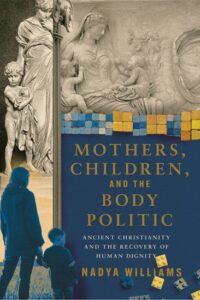When I was six years old, my parents were in the market to buy a house. I insisted that our new home include a “college suite” in which I would live while attending college. Around the same time, I announced that I wanted to be a working mom. When my parents asked me who would watch my kids, I matter-of-factly responded, “You will.”
I was right on both counts. The third floor of my childhood home became a “college suite” when my newlywed husband and I were finishing our post-graduate degrees during the Covid lockdowns. We were expecting our first child, and I soon began working full-time as my husband completed his studies. We continued living there while I worked remotely and my parents watched our baby—just as I had predicted.
Through my experience, I have come to see the value of multigenerational living, particularly for mothers juggling work and family. As we work to build a society that accommodates the reality of sexual asymmetry and embraces women’s capacity for motherhood, cultural and political support for multigenerational living is an essential component.
The Decline of Multigenerational Living
For most of American history, multigenerational living was the norm. The expectation that households would comprise one generation, or, at most, two (parents and their minor children), is partly a product of the Industrial Revolution, but it came to dominate the cultural mindset after WWII. Rates of multigenerational living plummeted between 1940 and 1980.
At the beginning of this time period, women entered the workforce en masse during WWII. After a brief decrease in workforce participation immediately after the war ended, they returned in greater numbers than ever, partly driven by the second wave feminism of the 1960s. The shift was most dramatic among women with children. According to the Pew Research Center, “one of the main drivers of increased labor force participation among women over the decades has been the sharp increase in the share of mothers in the workforce.”
As the enduring debates about work and motherhood attest, cultural expectations of women (and women’s expectations of themselves) did not just shift from the home to the workplace. They multiplied. Thus, demands on mothers increased in significant ways even as an important source of support—the presence of older generations in the home—was removed.
The landscape has changed again since the 1980’s, and multigenerational living has become more common. Nevertheless, cultural attitudes toward the practice remain fairly negative. While a majority of American adults in multigenerational households report having a positive experience, society is not exactly encouraging young couples to move into their parents’ houses.
Competing Cultural Narratives
Despite my early enthusiasm for multigenerational living, I eventually absorbed the notion that autonomy is the measure of success. For all the “it takes a village” platitudes, Americans idolize independence. Returning to my parents’ house felt socially acceptable as an emergency arrangement. But as our stay extended to two, then three years, and I became pregnant with our second child, I felt awkward describing my living situation to others. Although my husband and I had agreed that this was the best option for our family for the time being, part of me clung to the ideal of our own house and independence as the measures of good parenting.
These feelings do not reflect the overwhelmingly positive experience I have had in a multigenerational home. As I have struggled to tune out the negative cultural messaging, I have learned to embrace the blessing of our living arrangement, in part through conversations with friends and acquaintances. While dominant cultural narratives do not glorify multigenerational living, I have discovered that many individuals already value its benefits. Yes, there are the occasional uncomprehending responses and admonitions to “be kind to your husband” (as compensation for living with his in-laws), but often there is an encouragement or a positive personal experience.
One friend with a successful career, husband, and two kids moved in with her mother during the Covid lockdowns and would gladly do it again if job locations allowed. My midwife reminisced happily about the years of early motherhood she spent living in one half of her parents’ duplex. A professional acquaintance shared that her growing family had moved in with her parents so they could help with the kids while she worked. A common thread uniting these conversations, as well as my own experience, is that multigenerational living is uniquely valuable for women combining career and motherhood, often providing them with the built-in childcare, help with meals or housework, financial flexibility, and emotional support that can make all the difference in the work-life tug of war.
No More Mothering Alone
The biological and emotional realities of motherhood don’t fit neatly into to the male model of work-family balance (which, arguably, hasn’t been working well for men, either). Mother-friendly alternatives to the ideal worker model are just beginning to emerge, and women who seek a more integrated approach can often feel isolated.
Too often, the proposed solution to work-family conflict is “less family.” Given that American women are increasingly having fewer children than they desire, this is an unhelpful response. Women have made real legal, educational, and professional gains in the twentieth century, but the ideological hijacking of the feminist movement has predicated these gains upon the suppression of female fertility.
Restructuring policy and culture to accommodate both women’s desire for motherhood and their presence in the workforce is a complex task. An important piece of this puzzle is capitalizing on the familial network of mutual aid that already exists. In other words, the answer isn’t “less family,” it’s “more family.”
Thanks to the normalization of “pods” during the pandemic, I believe this shift is already underway. Policy change is needed, though, in areas such as zoning ordinances and housing grants so that they, at minimum, do not inhibit multigenerational living. We also need to revise the cultural narrative that idolizes “moving out” as the mark of adulthood and holds up the single-family home as the goal to which all young couples should aspire. By sharing positive experiences with multigenerational living and making explicit its benefits for working mothers, we can accelerate this process and encourage women to consider an option they might have otherwise dismissed.
It’s true that living with parents or other older relatives does not work for everyone. Logistical issues aside, some families have serious problems that make living together undesirable, and even families with strong relationships may find multigenerational living too stressful. If the older members of the household become infirm, the burden of caregiving may become too great for parents of young children, adding to work-life tension rather than easing it. Common criticisms of the multigenerational living model—for example, that it strains marriages or discourages adult children from taking on financial responsibilities—may be justified in some instances. Each family has different challenges and dynamics, and it is important to take these into account when discerning whether multigenerational living is the right step.
Still, generalizing such criticisms to discourage multigenerational living makes little sense. For centuries, multigenerational American homes turned out responsible adult citizens with rates of marital stability far above those of today. The idea that multigenerational living has suddenly become a liability in the twenty-first century is strange indeed—more a reflection of American culture’s increasing fixation with autonomy than of reality.
Don’t Lean In—Lean On
If our society were more welcoming toward multigenerational living, many women would discover that it is the missing ingredient in the quest to balance work and motherhood. What’s more, their families would discover that the arrangement is advantageous for them, too. Helping to care for grandchildren has been proven to lengthen grandparents’ lives, and the presence of younger family members can allow older Americans to age at home rather than moving into assisted living facilities.
Acknowledging the benefits of multigenerational living for mothers—“multigenerational mothering,” if you will—can help the conversation move beyond “lean in” and “lean out” and include a greater emphasis on how women can lean on others. Fathers are the most important source of support, but even mothers with highly engaged husbands or partners need additional help. For some, living closer to family members, relying on a church community, or asking for help from neighbors and single friends might be the best solution; for others, multigenerational living is worth a try.
Mothering is not meant to be done alone, and only a society obsessed with radical individualism and productivity could have convinced us otherwise. It is time to change the narratives surrounding women and work, and “multigenerational mothering” is a good place to start.



